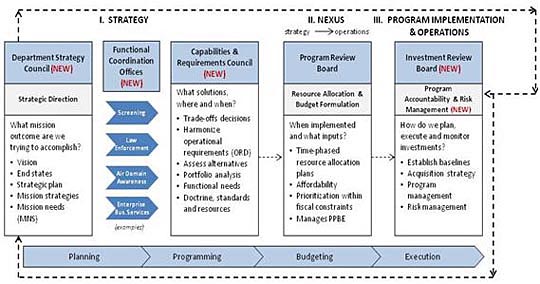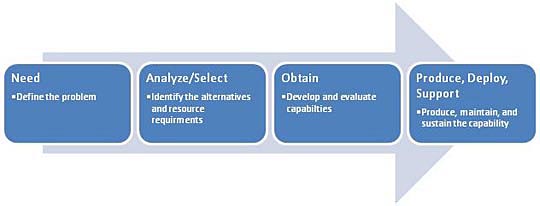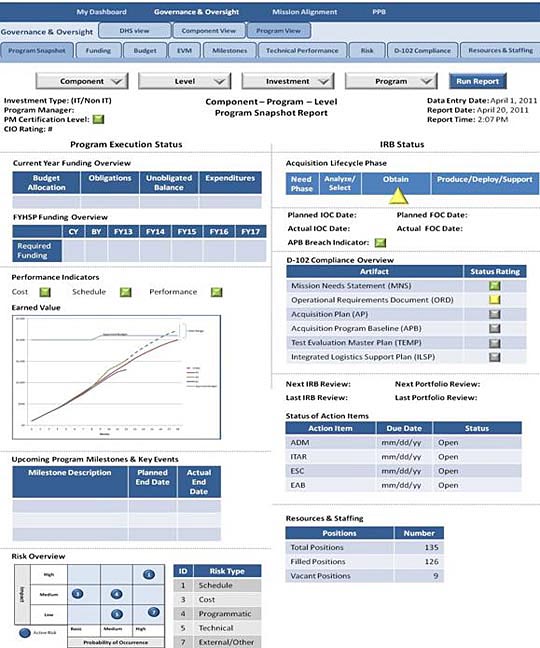Cannon House Office Building
Introduction
Chairman McCaul, Ranking Member Keating, and other distinguished members of the committee, I thank you for the opportunity to appear before you today.
Since my appointment, I have led the development and implementation of a comprehensive, strategic management approach focused on maturing organizational effectiveness within DHS. Through this effort, we are focused on enhancing the financial, acquisition, and human capital structures and processes necessary to meet DHS mission goals by integrating and aligning business functional areas at both the Departmental and Component levels. My approach has been built around three key elements:
- Acquisition Enhancement: Improving upon the current Department acquisition processes and procedures – addressing the "front end" requirements as well as "back end" program management in order to minimize risk, encourage fiscal responsibility, and improve end to end execution across the entire acquisition lifecycle.
- Financial Enhancement: Improving our financial systems and capabilities in both the management directorate and the components, emphasizing strong financial and analytical discipline throughout the department.
- Human Capital Management Enhancement: Making sure we have the right people in the right positions at the right time, with the proper workforce balance between DHS and contract staff.
I welcome the opportunity to focus today on the significant acquisition enhancements that are currently underway at the Department.
The successful delivery of major programs is a strategic business function of our Department. Nearly half of the DHS budget is dedicated to obtaining goods and services to support and improve our capabilities, including over $18 billion in investments in our acquisition programs. Those who directly carry out our mission require and deserve the tools and processes to help address their evolving mission needs effectively and efficiently. With limited resources and increasing demands, we understand that we must excel in all facets of planning, procuring, and managing the execution of our major programs.
The Secretary and Deputy Secretary have asked me to lead our ongoing effort to improve the overall acquisition management process, specifically focusing on strengthening the capabilities and requirements development process to better support the Department’s strategies and priorities while enhancing program execution. To that end, we have held a series of strategic meetings with the Chief Procurement Officer, Chief Information Officer, Component Acquisition Executives, Heads of Contracting Activity, and other program management professionals to gain valuable insight into the systemic weaknesses that we must overcome in order to deliver programs successfully.
Successful program management requires well-defined requirements based on our priority needs, effective strategies for developing solutions, and efficient processes to operate and maintain solutions. Our review of more than 80 major programs shows that our biggest challenges start with the requirements process and our lack of qualified program management staff.
Integrating Requirements and Acquisition Processes
I submitted a report to GAO in January 2011 titled, Integrated Strategy for High Risk Management. In that report, I committed to strengthening the strategic phase of the Integrated Investment Life Cycle Model. In the short time since the report was issued, significant progress has been made to strengthen investment management across the Department.
The Integrated Investment Life Cycle Model (see Figure 1) is an end-to-end process that integrates strategy, resources, and capabilities. It differs from prior efforts in that it is a formal, repeatable model that will span the DHS enterprise. Presently, operational units plan budgets based on a limited view of mission need. Under the integrated model, DHS will mature its "front-end" strategic phase, thereby providing a broader, enterprise-wide perspective and ensuring our investments address the greatest needs of the Department. The Integrated Investment Life Cycle Model will facilitate our ability to excel in all facets of planning, procuring, and managing the execution of our major programs.

Figure 1: Integrated Investment Life Cycle Model
To date, we have made significant progress towards establishing the Integrated Investment Life Cycle Model by:
- Designing and publishing the Integrated Investment Life Cycle Model (IILCM) in the Integrated Strategy for High Risk Management (January 2011);
- Identifying five (5) pilot programs to test the IILCM concept;
- Forming an initial set of Functional Coordination Offices (FCOs) to provide analytical support;
- Planning for the first Capabilities and Requirements Council (CRC) to meet in early Quarter 4 of Fiscal Year 2011 to validate requirements;
- Initiating the development of a Decision Support Tool (DST) to provide enhanced analytic support for major acquisition programs; and
- Continuing the Program Review Board and Acquisition Review Boards (ARB) for providing decisions for ongoing investments. Ultimately the ARB will migrate to a new Investment Review Board that has a more holistic reach.
I recognize that effective vendor engagement in the acquisition process is critical to competition, the identification of commercial item solutions, and the realization of savings. However, the speed at which we achieve these objectives must be balanced against the need to abide by statutes, rules, and regulations.
While the Integrated Investment Life Cycle Model is in the initial stages of development, we are confident that it will significantly improve our decision-making processes and are committed to making it successful. The model will result in improved collaboration among our Components, greater efficiencies, and an enhanced ability to ensure our investments are highly responsive to the capability needs of the homeland security enterprise. It will also help the Department clearly articulate our long term strategic acquisition needs, which will improve industry’s understanding of our requirements and promote a more competitive marketplace. This will ultimately result in more efficient and innovative solutions to help the Department achieve its mission.
The Pre-Acquisition Process
There is significant unrealized value in maturing the pre-acquisition process. In the earliest phases of concept development and program initiation, the Department's Science and Technology Directorate (S&T) can help define the appropriate technological solutions and perform feasibility analysis. This can occur while studying the affordability, performance, and viability of various alternatives.
The continuous performance of requirements management is essential throughout the acquisition life cycle, but is most critical during the earliest planning phase. DHS is strengthening our front-end process by providing greater rigor and oversight of the development of requirements. To that end, we have formally incorporated the role of S&T in the development of all technology requirements for the Department. S&T is in a unique position to evaluate new and emerging technologies against capability gaps, which will increase technological expertise and assist the Department in making better technology "buy" decisions for the DHS Enterprise.
S&T has the statutory authority to serve a significant role in the management of Departmental acquisitions as the Directorate is charged to, "conduct basic and applied research, development, demonstration, testing, and evaluation activities relevant to any or all elements of the Department."1 The Homeland Security Act provides sufficient guidance as to "what" S&T should be doing in the management of acquisitions. An enhanced Integrated Investment Life Cycle Model will better identify "how" S&T will serve a key role in acquisition management.
As Under Secretary O'Toole has noted, "a critical part of successfully transitioning technology is gaining an accurate understanding of the customer needs at the beginning of the project." 2 I am pleased that Under Secretary O’Toole has established the Acquisition Support and Operations Analysis Group to leverage technical expertise and assist DHS Components' efforts. Leading this critical role for S&T is Director Henry Gonzalez, who is responsible for connecting S&T projects to the operational Components, developing the Integrated Product Team process to identify component technology needs, and linking S&T investments to those needs.
The Acquisition Support and Operations Analysis Group will leverage S&T's critical mass of technical capability and will work in close collaboration with the Management Directorate to:
- Aid the components in developing high-fidelity, testable operational requirements for their acquisitions
- Aid in executing an analysis of alternatives to ensure that the most appropriate technical approach is taken; and
- Partner with the components throughout an acquisition so that user needs are translated into real capabilities that can be validated upon delivery and deployed without delay.
My colleagues in the S&T will expound upon this effort and how it will guide, support and strengthen the process.
Improving the Definition of Requirements
In addition to S&T's efforts previously mentioned, the Management Directorate is establishing a Center of Excellence for Requirements. The purpose of this Center is to support DHS Component awareness, understanding, and use/adaptation of proven best practices, which will provide DHS program managers with proven tools, processes, and training. The Requirements Center of Excellence will establish a well-defined and repeatable approach to requirement definition to ensure that our process guidance explains the information needed for success. The goal is to support the use of best-in-class requirements management and execution tools, and standardize operating models for how to best use the tools.
The greatest value of this effort will be our ability to link emerging and existing capabilities to operational requirements. A key challenge will be harmonizing requirements across seemingly disparate components and investments.
The Acquisition Process
The Department's acquisition management framework is growing stronger through the refinement of our policy, processes, procedures, and the placement of people with the right skill sets in the program offices. The goal is for every major program to be implemented in the most responsible and efficient manner possible. Our enterprise-wide acquisition framework is a key element of our integration strategy, and the Department has taken a number of steps to strengthen it.
I have gained valuable insight from conversations I have had with the private sector, specifically those large and small businesses doing work with DHS. The product of those conversations has, in part, helped shape our strategy for maturing our acquisition process, and has resulted in a more constructive dialogue and feedback loop with our private sector partners. It is essential that we maximize our investments in the goods and services we acquire to help us achieve our mission.
DHS has implemented the final version of Acquisition Management Directive 102-01. Directive 102 formalizes the role of the Acquisition Review Board in the oversight and governance process by establishing criteria for reviewing and approving a program’s progress through a standard investment life cycle (See Figure 2). The implementation of this directive has resulted in productive interactions between program offices and Department leadership allowing us to mitigate or avoid unnecessary costs, review schedules, and evaluate performance risks.
The cornerstone of our acquisition review process is the program baseline. The acquisition program baseline formally documents critical cost, schedule, and performance parameters that must be met to accomplish the program’s goals. By tracking and measuring actual program performance against baseline, management is alerted to potential problems and can take corrective action.

Figure 2: DHS Investment Life Cycle
The Department has provided standardized structure to the Acquisition Review Board presentation materials, focusing on six key areas that all programs must report progress on. These include cost, performance, schedule, risk, funding profile, and staffing. Other challenges that are unique to the program are discussed, but standardizing the opening dialog of the Acquisition Review Board has resulted in better focus on the key issues of program execution.
Additionally, the formalized role of S&T's Testing and Evaluation in the acquisition review process institutionalizes the rigor of proper test procedures and plans in the acquisition process.
Another important step in strengthening acquisition program management is managing risk. We are developing a risk management capability within our decision support tool as well as a standard criterion to evaluate program execution risks. This module will provide for a centralized means to track risks both at the Department and Component level. Acquisition Review Boards, portfolio reviews, and day-to-day oversight all aid in identifying risks faced by programs. As critical risks are identified, steps are taken to place a program on a path to successfully deliver capability to operators.
A central tenet of the Department's management integration strategy is the collection and dissemination of business intelligence and a centralized Decision Support Tool (DST) (See Figure 3). Utilization of these tools will help us better manage the complex relationships between mission objectives, program strategy and performance metrics for a specific program.

Figure 3: Decision Support Tool
When fully deployed, the Decision Support Tool will be the authoritative source for governance boards on the health of individual programs and help determine "go/no-go" decisions. The goal of a Decision Support Tool is to strengthen accountability for program management and to develop a common language and discipline for all program investments by communicating indicators that inform the health status of programs and provide general performance predictors.
From a strategic level, the Decision Support Tool system will accomplish the following:
- Organize data in a template that guides business owners through a series of uniform questions to assess the risk of an investment,
- Weigh each response with risk-based algorithms scored to determine a program's risk relative to the Department's strategic goals and other competing investments,
- Assess the progress of each program during its life cycle on a periodic basis (e.g., quarterly) relative to pre-established measures,
- Provide a series of customizable reports on program status in a dashboard format that is visible to designated officials, according to permission-based roles and responsibilities, and
- Store key data for historical use, record data modifications, and allow users to submit documentation to support ratings.
By combining the strengths and merits of the Integrated Investment Life Cycle Model with a department-wide Decision Support Tool, we will have the structure, processes, and systems necessary to strategically, effectively, and efficiently manage our mission goals.
Conclusion
DHS is working to improve the effectiveness of the acquisition lifecycle and provide better linkages between requirements development, resource allocation, procurement and program management. The Integrated Investment Life Cycle Model is a holistic approach to how DHS investments should be managed.
Once again, I thank you for the opportunity to appear before you today, and I look forward to answering your questions.
